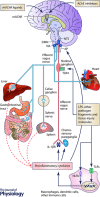Anti-inflammatory properties of the vagus nerve: potential therapeutic implications of vagus nerve stimulation
- PMID: 27059884
- PMCID: PMC5063949
- DOI: 10.1113/JP271539
Anti-inflammatory properties of the vagus nerve: potential therapeutic implications of vagus nerve stimulation
Abstract
Brain and viscera interplay within the autonomic nervous system where the vagus nerve (VN), containing approximately 80% afferent and 20% efferent fibres, plays multiple key roles in the homeostatic regulations of visceral functions. Recent data have suggested the anti-inflammatory role of the VN. This vagal function is mediated through several pathways, some of them still debated. The first one is the anti-inflammatory hypothalamic-pituitary-adrenal axis which is stimulated by vagal afferent fibres and leads to the release of cortisol by the adrenal glands. The second one, called the cholinergic anti-inflammatory pathway, is mediated through vagal efferent fibres that synapse onto enteric neurons which release acetylcholine (ACh) at the synaptic junction with macrophages. ACh binds to α-7-nicotinic ACh receptors of those macrophages to inhibit the release of tumour necrosis (TNF)α, a pro-inflammatory cytokine. The last pathway is the splenic sympathetic anti-inflammatory pathway, where the VN stimulates the splenic sympathetic nerve. Norepinephrine (noradrenaline) released at the distal end of the splenic nerve links to the β2 adrenergic receptor of splenic lymphocytes that release ACh. Finally, ACh inhibits the release of TNFα by spleen macrophages through α-7-nicotinic ACh receptors. Understanding of these pathways is interesting from a therapeutic point of view, since they could be targeted in various ways to stimulate anti-inflammatory regulation in TNFα-related diseases such as inflammatory bowel disease and rheumatoid arthritis. Among others, VN stimulation, either as an invasive or non-invasive procedure, is becoming increasingly frequent and several clinical trials are ongoing to evaluate the potential effectiveness of this therapy to alleviate chronic inflammation.
© 2016 The Authors. The Journal of Physiology © 2016 The Physiological Society.
Figures


References
-
- Altschuler SM, Escardo J, Lynn RB & Miselis RR (1993). The central organization of the vagus nerve innervating the colon of the rat. Gastroenterology 104, 502–509. - PubMed
-
- Bellinger DL, Felten SY, Lorton D & Felten DL (1989). Origin of noradrenergic innervation of the spleen in rats. Brain Behav Immun 3, 291–311. - PubMed
-
- Benarroch EE (1993). The central autonomic network: functional organization, dysfunction, and perspective. Mayo Clin Proc 68, 988–1001. - PubMed
-
- Bernik TR, Friedman SG, Ochani M, DiRaimo R, Susarla S, Czura CJ & Tracey KJ (2002. a). Cholinergic antiinflammatory pathway inhibition of tumor necrosis factor during ischemia reperfusion. J Vasc Surg 36, 1231–1236. - PubMed
Publication types
MeSH terms
Substances
LinkOut - more resources
Full Text Sources
Other Literature Sources
Medical

